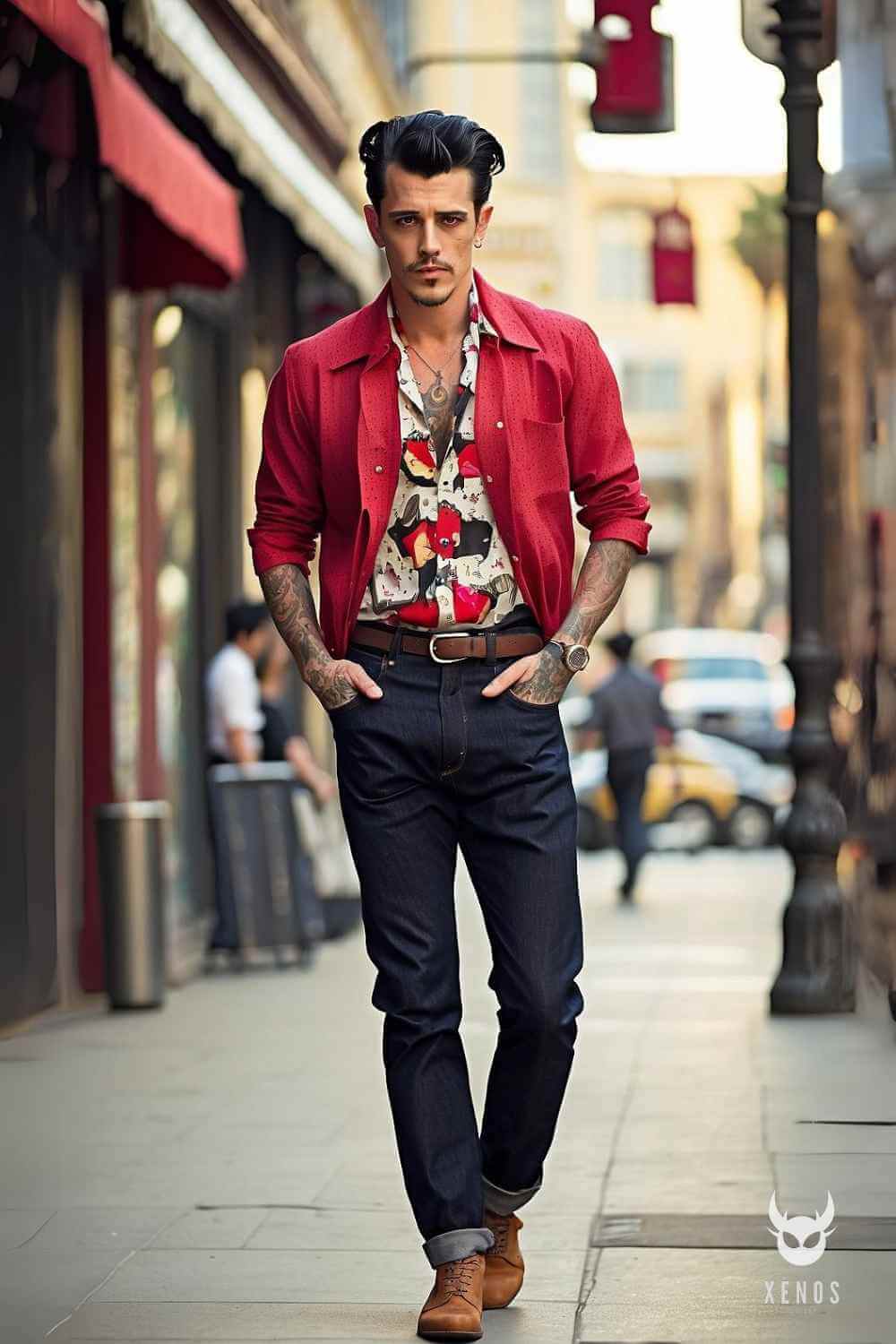Rockabilly: a term that instantly conjures images of slick-backed hair, leather jackets, and the unmistakable sound of the 1950s rock 'n' roll.
But there's so much more to this iconic style than meets the eye.
Rockabilly, often perceived merely as a fashion trend, is deeply rooted in a musical revolution that shook the 1950s, blending the wild rhythms of rock 'n' roll with the down-home charm of country music.
This guide isn't just about dressing in vintage gear; it's about immersing yourself in a subculture that celebrates uniqueness and defies the ordinary.
Key Takeaways
- Rockabilly: Where 50s music meets fashion.
- Essentials: leather jackets and cuffed jeans.
- Signature looks: pompadour hairstyles and retro shirts.
- Must-have footwear: Dr. Martens, brogues, and creepers.
- Tattoos: Icons of rebellion and individuality.
- Accessories: The final touch to a Rockabilly outfit.
The Roots of Rockabilly Style
Rockabilly emerged from the post-war era, blending rock 'n' roll's energy with country music's soul. It's a style deeply rooted in musical legends like Elvis Presley and Jerry Lee Lewis, who not only defined a genre but also set the tone for a fashion revolution.
Rule One: Selecting the Perfect Jacket

A Rockabilly jacket is more than just fabric; it's a declaration of style. Whether it's rugged leather or vintage denim, the right jacket speaks volumes.
Personalizing your jacket, whether through natural wear or creative distressing, adds authenticity to your Rockabilly persona.
Customizing your jacket to give it a lived-in look is a hallmark of Rockabilly authenticity.
Techniques like distressing denim with a cheese grater or softening leather with alcohol can add character to your jacket, making it uniquely yours.
Rule Two: Mastering Rockabilly Jeans and Trousers

Rockabilly isn't just about the upper half; the jeans or trousers you choose are equally critical. Traditional Rockabilly style often features dark or black denim jeans, usually with a cuffed hem. Today, there's more flexibility in the fit – skinny, slim, or straight cuts are all acceptable as long as they complement your overall look.
The key is to wear what feels right.
Rockabilly is as much about comfort and confidence as it is about style.
For further inspiration on combining different elements to create a unique look, check out Edgy Style, which offers insights into blending various style elements.
Rule Three: The Art of Rockabilly Shirts

The Rockabilly shirt is an art form in itself. Plaid and bowling shirts are staples, ideal for layering under your jacket.
These shirts, whether in classic gingham or a more audacious tartan, add a retro touch to the ensemble.
The key is to mix and match shirts that complement the rest of your outfit while keeping in line with the Rockabilly aesthetic.
For more on how to mix and match different styles, the Random Outfit Generator on Xenos Jewelry offers a fun and creative way to explore new combinations.
Rule Four: Footwear for the Rockabilly Aficionado

Footwear is the cornerstone of any Rockabilly outfit. Classic Dr. Martens or vibrant brogues can perfectly encapsulate the Rockabilly spirit. Here's a breakdown of popular Rockabilly footwear styles:
| Footwear Style | Description and Style Notes |
|---|---|
| Dr. Martens | Synonymous with durability and edge. Classic black or cherry red are popular choices, perfect for a rugged, rebellious look. |
| Vibrant Brogues | Add a pop of color and retro flair. Look for two-tone options or bright hues to make a statement. |
| Creepers | Known for their thick soles and unique style, ideal for adding an unconventional, punk-inspired edge to your outfit. |
| Classic Loafers | Sleek and simple, they bring a touch of sophistication and are a nod to the more refined side of Rockabilly fashion. |
| Saddle Shoes | A 1950s staple, offering a nostalgic touch with their distinctive two-tone design, perfect for a classic Rockabilly look. |
| Cowboy Boots | Reflect the country roots of Rockabilly music. Look for traditional designs or ones with modern twists like unique colors or embroidery. |
| Wingtip Shoes | Classic and timeless, wingtips are versatile and can be dressed up or down, embodying the fusion of vintage and modern styles. |
Rule Five: Crafting the Rockabilly Hairstyle

Your hairstyle is not just a part of your Rockabilly identity; it's a bold statement of your affinity with this iconic culture. The Rockabilly scene is renowned for its distinctive hairstyles, which are as integral to the style as the music and clothing.
- The Classic Pompadour: This is perhaps the most emblematic Rockabilly hairstyle. It features hair swept upwards from the face and worn high over the forehead, often slicked back with pomade. The pompadour can be adapted for various hair lengths and types, making it a versatile choice for any Rockabilly enthusiast.
- The Quiff: Similar to the pompadour, the quiff combines elements of the pompadour, flattop, and sometimes a mohawk. This style is characterized by longer hair at the front, which is styled upward and backward, creating a prominent wave. For a more modern twist, some opt to pair the quiff with shaved sides for a sleek, contemporary look.
- Greaser Hairstyle: Inspired by the 1950s rebel culture, the greaser hairstyle is all about slick, shiny hair achieved with liberal amounts of pomade. The hair can be combed back, into a ducktail, or even into a more elaborate jelly roll style.
- Side Parted Styles: For those preferring a subtler Rockabilly look, side-parted styles offer a more understated option. Hair is combed to one side with a defined parting, often complemented by a slight pomade shine for that classic 50s touch.
- Modern Adaptations: Today's Rockabilly hairstyles often incorporate contemporary elements. Think of undercuts, color streaks, or textured layers for added depth and modernity. These adaptations make the Rockabilly hairstyle accessible and appealing to a broader audience, allowing individuals to express their personal style while staying connected to Rockabilly roots.
Complement your look with insights from Men's Edgy Haircuts, which discusses how style transcends clothing.
Rule Six: Accessories to Define Your Style

In the Rockabilly scene, accessories are not just additions; they're statements of identity. Each piece, whether subtle or bold, adds layers of depth and personality to your Rockabilly attire. Here's a deeper dive into the types of accessories that can elevate your Rockabilly look:
- Braces (Suspenders): These aren't just practical; they're a throwback to the classic 50s style. Opt for bold colors or patterns to make a statement or choose traditional black for a more subdued look.
- Sunglasses: Classic styles like Wayfarers or Aviators are perfect for adding a touch of cool to your outfit. They're not just for sunny days; they're an integral part of the Rockabilly attitude.
- Metal Jewelry: Think chunky, bold, and edgy. Items like thick chain necklaces or large rings can add an element of toughness to your look. Explore our Gothic Jewelry collection for pieces that combine dark elegance with a rebellious spirit.
- Skull Rings: These are quintessential for adding an edge to your Rockabilly style. They represent the rebel ethos and are a nod to the subculture's love for the unconventional. Find your perfect ring in our Skull Rings collection, including options from our specialized Biker Rings and Black Skull Ring selections.
- Necklaces: From dog tags to pendants featuring rock 'n' roll motifs, necklaces are a way to show off your personal style. They can be as understated or as bold as you like. Browse our Necklaces collection for a variety of styles that suit the Rockabilly aesthetic.
- Earrings: Whether you prefer studs or something more elaborate, earrings are a subtle way to add Rockabilly flair to your outfit. Our Earrings collection offers a range of designs that can complement any Rockabilly look.
- Leather Accessories: Leather wristbands, belts, and watch straps are staples in the Rockabilly wardrobe. They add a rugged, masculine touch to the ensemble.
- Bandanas and Scarves: These can be worn around the neck or as a headband to add a splash of color and pattern to your outfit, embodying the Rockabilly's blend of toughness and style.
Tattoos: Expressing the Rockabilly Rebel Spirit

Tattoos in Rockabilly culture are far more than mere body art; they are emblematic of the ethos and history of this unique style.
In the Rockabilly world, each tattoo is a narrative of rebellion, individuality, and a deep connection to the music and aesthetics of the 1950s.
Let's delve into some common themes and designs that are prevalent in Rockabilly tattoos:

| Tattoo Theme | Description and Significance |
|---|---|
| Classic Americana Designs | Motifs like anchors, eagles, and flags, symbolizing nostalgia and homage to the 1950s American culture. |
| Musical Icons | Tattoos of musical instruments, vinyl records, or portraits of icons like Elvis Presley, representing the rockabilly roots. |
| Retro Pin-Up Models | Iconic 50s-style pin-up girls, reflecting the era's glamour and the fusion of beauty with rockabilly style. |
| Hot Rods and Classic Cars | Vintage cars and hot rods, signifying freedom and the golden era of automotive design. |
| Swallows and Roses | Swallows symbolize travel and returning home; roses represent love and passion, common in wanderlust themes. |
| Dice and Cards | Representing gambling and risk-taking, these motifs embody the edgy, rebellious side of Rockabilly culture. |
| Skulls and Flames | Skulls signify mortality and a life lived boldly; flames add a sense of danger and intensity to the design. |
FAQs: Embracing Rockabilly Men's Style
In this section, we address common questions about adopting and perfecting Rockabilly men's style, helping you navigate the nuances of this unique fashion statement.
How to dress 1950s style men?
To dress in a 1950s style, men should focus on classic pieces that define the era:
- Leather Jackets: Opt for a classic leather biker or bomber jacket.
- High-Waisted Trousers: Choose pleated trousers that sit high on the waist.
- Cuffed Jeans: Dark denim jeans with a cuff at the bottom are quintessential.
- White T-Shirts: Plain white tees, often worn under an open shirt or jacket.
- Slicked-Back Hair: Hairstyles like the pompadour or slicked-back look were popular.
- Oxford Shoes or Loafers: Footwear should be classic and polished.
- Accessorize: Add elements like fedoras, sunglasses, and wristwatches to complete the look.
What's the difference between rockabilly and rock and roll?
- Musical Roots: Rockabilly is a subgenre of rock and roll. It combines the rhythm and blues of rock and roll with the twang and storytelling of country music.
- Fashion: Rockabilly fashion includes elements like leather jackets, cuffed jeans, and retro shirts, often paired with hairstyles like pompadours. In contrast, classic rock and roll style is more diverse, ranging from the glitz of glam rock to the casualness of folk rock.
- Cultural Influence: Rockabilly has a distinct culture that involves vintage cars, tattoos, and a nostalgic appreciation for the 1950s Americana, whereas rock and roll is broader, encompassing various subcultures and eras.
Why is it called rockabilly?
- Etymology: The term "Rockabilly" is a portmanteau of "rock" (from "rock 'n' roll") and "hillbilly," the latter a reference to country music often played in the Southern United States.
- Cultural Significance: The name reflects the music's blend of rock and roll's upbeat rhythms with the country's storytelling and twang. It emerged as a distinct style in the early 1950s and quickly became a defining genre of the era.
- Identity: The term now not only identifies a music genre but also a fashion style and a broader cultural movement that harkens back to the values and aesthetics of the 1950s.








